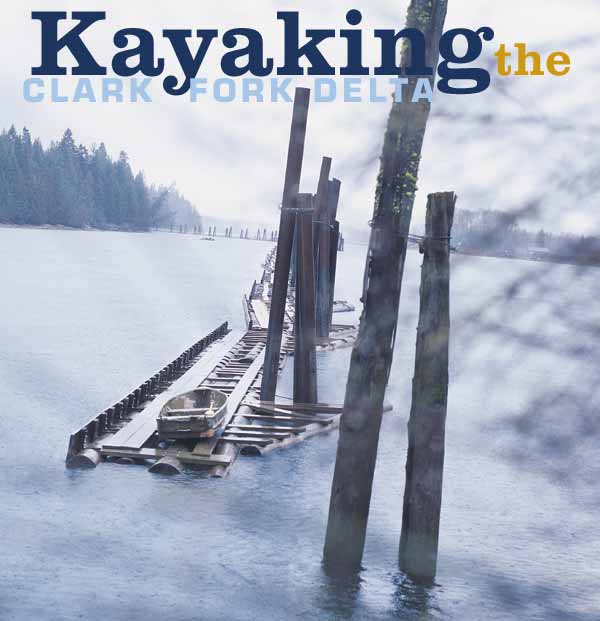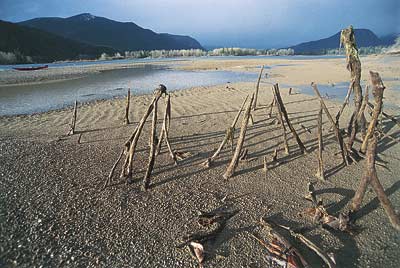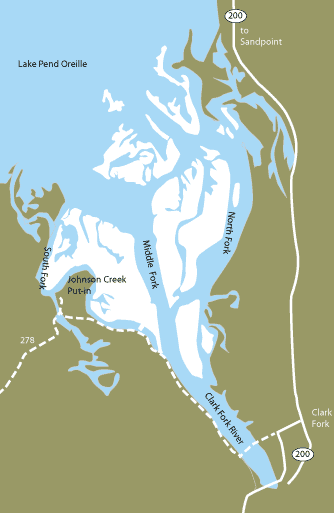 |
|
Photo by Grayson Schaffer
|
Story and photos by Grayson Schaffer
Clutching a deep-fried Harold’s burrito in one hand and the steering wheel in the other, I cruised the contours of Highway 200 along Lake Pend Oreille’s north shore, a sea kayak strapped to the roof. It was only March, but the rains had already made cascades of the roadside cliffs. Spring’s first golden green was out there somewhere, and if I had remembered to change my wiper blades, I might have caught a glimpse of it. Through the blur, the mountains of the Clark Fork Valley began to rise up, into the clouds like a gateway onto the lake. They form a boxy U shape nearly 2,000 feet tall, the floodgates of what was once the world’s largest river.
 |
|
Evidence of an old forest stands at the mouth of the Clark Fork River.
|
|
In 1923 a University of Chicago geologist named Harlan Bretz put forth the idea of a raging torrent inundating northern Idaho. Without the aid of satellite imaging, Bretz observed the behavior of the erosion in the area and concluded that only water could have scoured the land in such a way. Under the prevailing idea of uniformitarianism, Bretz’s theory was received with the same incredulity as Darwin’s Origin of the Species.
Though the debates have been fierce and recent, geologists now agree that the floods occurred repeatedly during the end of the last ice age. The ice dam that formed at the mouth of the Clark Fork would fail as the rising water would first lift and then fracture it. The result was a 2,000-foot wall of water racing to the Pacific at 70 miles per hour.
Now, thousands of years later, the Clark Fork Delta is a braided maze of channels ideal for sea kayaking. At the Johnson Creek put-in, I piled on warm clothes, grabbed a fresh burrito and slid the boat into the water. The laminated aerial photos that Josie Merithew, owner of Full Spectrum Tours, had given me looked simple enough. There were many channels neatly arcing and intersecting with each other. All I needed to do was paddle downstream and take a right. After putting a finger to the wind, sealing my spray skirt and checking the map one last time, I headed out upstream. About an hour later, flailing against the current and terrifying waterfowl, I finally made it to the main channel. It doesn’t look that big on the maps, but the delta is definitely big enough to lose yourself.
With the misguided labor behind me, I pulled my hood up against the rain and drifted on the current. A sea kayak rises only inches out of the water and is barely wider than your waist. It glides easily and, with the skill I lack, almost gives you back more energy than you put in. You feel like you are wearing it rather than riding in it.
Lying against the back deck I watched the trees, still bare, pass by. The eagles are easy to spot clinging to the bald branches. Under their weight the treetops sway out over the water, giving them a sidelong vantage of anything swimming below.
 |
 |
|
The Clark Fork Delta’s braided channels
|
|
At the river’s mouth, there is a partially submerged forest with surreal rotting stumps standing on their roots like cypress trees. In the wind their knobby legs wobble and clatter as if they have somewhere to go.
At some point, a silver mine is planned for this drainage. It always makes me think of the Coase Theorem. Ronald Coase, a University of Chicago economist, won the Nobel Prize for his clarification of the significance of property rights. His theorem maintains that, “Externalities can be internalized by governments establishing property rights to resource use and ... ” What the man is trying to say is that at a lake where one group of people wants to swim, fish and otherwise make merry and another group of people wants to turn it into their own personal sewage dump in the name of jobs and progress, all you need to do is assign property rights over the lake to either group, and the situation will sort itself out on the open market.
On graph paper, it looks even better. There are curves and lines arcing and intersecting with each other that somehow represent the conflict. One swipe of the pencil brings the world from the brink of chaos into perfect efficiency.
Somehow, though, down here at water level, things look a bit different. Drifting along, I wondered what the price tag on Lake Pend Oreille might be and how big a bake sale it would take to buy back the lake. In most disciplines, the practitioner observes behavior and then fashions a model. Strangely, in economics, the model comes first, and we alter our behavior to fit it. Oh well, thanks for the clarification anyway, Ron.
The rain broke and the wind picked up from across the lake, working up a pretty good swell at the river mouth. I surfed a few waves from the lake back towards the river and then decided to call it quits. The night skiing lights at Schweitzer were starting to come on, and the temperature had dropped. With any luck I could make it back to town in time for dinner with some friends.
Directions and Resources
To get to the Johnson Creek put-in, take Highway 200 east from Sandpoint to the town of Clark Fork. Take a right on Stevens Road. Cross the railroad tracks and take a left to the new bridge over the Clark Fork. Take an immediate right after the bridge. It is 2.5 miles to Johnson Creek from the bridge.
In addition to the Clark Fork Delta, the Pack River Delta is also an excellent day trip. You can rent kayaks and get information from Full Spectrum Tours, (208) 263-5975; Outdoor Experience, (208) 263-6028; or All Season Recreational Rentals, (208) 255-2431.
If you are new to sea kayaking, it is a good idea to use a guide service. Full Spectrum offers guided tours. There is also a useful book called Paddle Routes of the Inland Northwest by Rich Landers and Dan Hansen that details most of the area. Most bookstores and outfitters in these parts should carry it.
The trail skirted past house-sized stones, then climbed to the lip of Lake Estelle. She was a beauty. I sat on a log, my brow massaged by soothing breezes playing across ripples mirroring the cliffs, timber and meadows framing the docile lake. But the sun had begun its slide to the western horizon and there was one more lake to see.
|